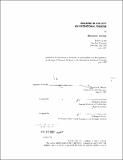| dc.contributor.advisor | Wellington Reiter. | en_US |
| dc.contributor.author | Slattery, Maureen L. (Maureen Louise) | en_US |
| dc.contributor.other | Massachusetts Institute of Technology. Dept. of Architecture. | en_US |
| dc.date.accessioned | 2012-04-26T18:35:30Z | |
| dc.date.available | 2012-04-26T18:35:30Z | |
| dc.date.copyright | 1997 | en_US |
| dc.date.issued | 1997 | en_US |
| dc.identifier.uri | http://hdl.handle.net/1721.1/70285 | |
| dc.description | Thesis (M. Arch.)--Massachusetts Institute of Technology, Dept. of Architecture, 1997. | en_US |
| dc.description | Includes bibliographical references (p. 79-81). | en_US |
| dc.description.abstract | The city is to be considered a site of power. Privileged, gendered, uneven, the city exercises authority and control over its inhabitants. What masks as public, in truth, is private. Its space and structures are fixed by its economic and political operations, impenetrable to the lived practices of its inhabitants. To transgress boundaries is to reclaim urban space for its residents. Urbanism is recast as a space of social production; the city is a contested site. The city as theatre reveals a totalizing impulse. The theatrical city suggests a scopic tendency, an image of the city grasped as a whole. Theatre itself is much more elusive; its definitions multiply. As scenography, it reasserts authority; as performance it infiltrates; as spectacle; it alienates; as drama, it contests. Theatre in the city operates at this intersection; its stage is mutable, its architecture muted. This thesis is then a strategy of inhabiting the city. Normal conceptions of the public city are set aside, the definition is appraised anew. To construct a momentary encounter that interrupts the familiar, reclaims territory. Occupying the unknown, viewing from below are tactics to remap the city. The program is a constructed theatre, sited and re-sited in New York City. To be assembled in place, the project intends to appropriate given public space and redefine it as a public space for performance. The inherent transmutive qualities of the stage and performance are appropriated for the building. The question becomes: How does a theatre operate in the city? | en_US |
| dc.description.statementofresponsibility | by Maureen L. Slattery. | en_US |
| dc.format.extent | 85 p. | en_US |
| dc.language.iso | eng | en_US |
| dc.publisher | Massachusetts Institute of Technology | en_US |
| dc.rights | M.I.T. theses are protected by
copyright. They may be viewed from this source for any purpose, but
reproduction or distribution in any format is prohibited without written
permission. See provided URL for inquiries about permission. | en_US |
| dc.rights.uri | http://dspace.mit.edu/handle/1721.1/7582 | en_US |
| dc.subject | Architecture. | en_US |
| dc.title | Walking in the city--an operational theater | en_US |
| dc.type | Thesis | en_US |
| dc.description.degree | M.Arch. | en_US |
| dc.contributor.department | Massachusetts Institute of Technology. Department of Architecture | |
| dc.identifier.oclc | 37554042 | en_US |
